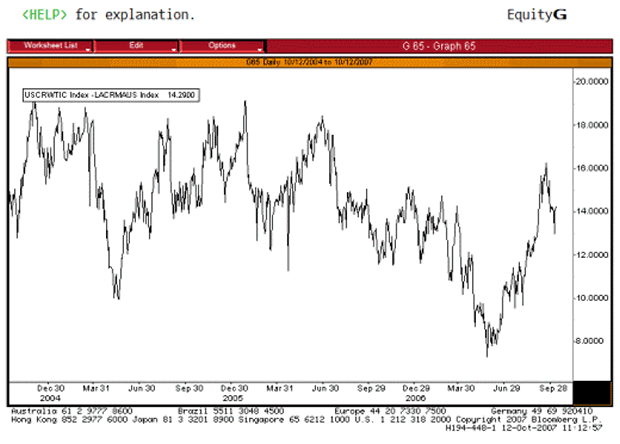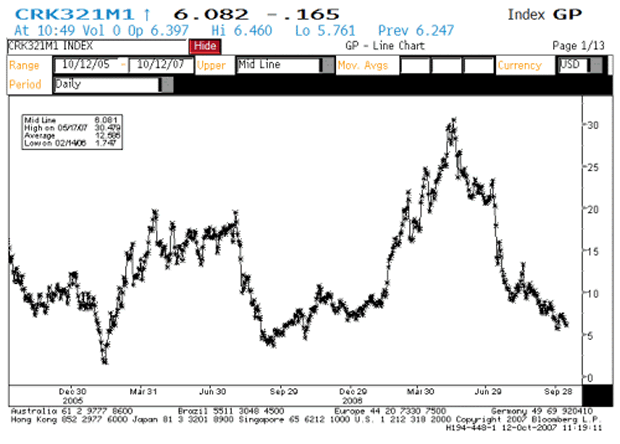Oil Refiners Profit Margins Seasonal Weak As Crude Oil Rises and Gasoline Prices Fall
Companies / Oil Companies Oct 16, 2007 - 10:55 AM GMTBy: Elliot_H_Gue

 During the past two weeks, we've heard negative pre-announcements or weaker-than-expected earnings guidance from a number of energy firms, including Marathon Oil , Valero Energy and Chevron Corp . To some, this appears incongruous: With crude trading near all-time highs, the conventional wisdom is that these firms should be making record profits.
During the past two weeks, we've heard negative pre-announcements or weaker-than-expected earnings guidance from a number of energy firms, including Marathon Oil , Valero Energy and Chevron Corp . To some, this appears incongruous: With crude trading near all-time highs, the conventional wisdom is that these firms should be making record profits.
But it's just not that simple. Obviously, oil producers tend to make more money when the price of crude oil rises. The oil exploration and production (E&P) side of the energy business is on fire right now. The weak link for most of the firms pre-announcing to date has been refining, perhaps the most misunderstood business in the energy patch.
Valero is the largest independent refining firm in North America and derives almost all its revenues from that business. Chevron and Marathon are both integrated oil companies but derive about 25 percent and 50 percent of their operating profits, respectively, from refining. You can't analyze any of these companies meaningfully without considering the profitability of the refining side of the business alongside that of E&P operations.
The Refining Game
Refiners don't make money by selling crude oil or, for that matter, natural gas. In fact, refiners are often actually hurt by rising crude oil prices.
Although crude oil is the subject of endless chatter on the news, we don't really consume crude oil directly. You don't fill the petrol tank on your car with oil, nor do you run trains, home heaters, airplanes or power plants using crude oil. Crude oil is just a raw material; what we actually consume is refined product. Refined products include gasoline, heating oil, jet fuel and diesel.
Refiners are key middlemen between crude oil and actual, usable products. These firms buy crude oil as the feedstock for their operations and produce and sell gasoline, diesel and other products. Therefore, they make money from the spread between crude oil prices and prices of refined products, not the price of crude or gasoline alone.
If the price of gasoline rises faster than the price of crude, profit margins for refiners would tend to expand. And refiners can, of course, actually make money when crude oil prices are falling. For example, if crude prices are drifting lower but gasoline costs are rising or remaining steady, this will support refiners' margins.
The basic measure of a refiner's profitability is what's known as a crack spread. The term comes from the fact that refiners are said to "crack" a barrel of crude to make products. The crack spread is generally calculated by comparing the cost of crude oil futures with the price of refined products futures--typically gasoline and heating oil futures.
Beyond the Crack Spread
Although the crack spread is a valuable estimate of refiners' overall margins, it's just that--an estimate. Refiners aren't totally beholden to the crack spread, and actual profit margins at an individual refinery depend on a multitude of different factors.
The closely related factors of complexity and feedstock are another key fundamental to watch carefully. Specifically, crude oil isn't a homogeneous product.
Every day in the newspaper and all over the Internet, we hear of crude trading at $78 or $85 per barrel as if it were just one commodity with one price. Typically, the price we hear about will be the New York Mercantile Exchange (NYMEX) futures price, which is based on the price of light, sweet crude oil.
You'll also hear talk of Brent crude, a standard for oil sourced from the North Sea of the United Kingdom and Norway. The name comes from the Brent oilfield, located northeast of Scotland's Shetland Islands.
But these are just common types of crude and certainly don't represent the current trading price of every grade of crude on Earth.
Oils are typically described based on two basic properties--specific gravity and sulphur content. In the petroleum business, the standard measure of specific gravity is API gravity. (API stands for American Petroleum Institute.) The higher the API gravity, the "lighter" or less dense the crude oil.
Crude oils are graded by API gravity. For example, crude oils with an API gravity of more than 31.1 degrees are considered light crude oils. When you hear the term light, sweet crude on the news, that's exactly what they're talking about. Crude oils with an API gravity of less than 21.5 degrees are, as you may have already guessed, called heavy crude oils.
For example, Brent crude typically has API gravity around 38 to 39, so it's considered a light crude. The NYMEX crude oil futures contract also calls for crude with not less than 37 degrees API gravity nor more than 42 degrees API gravity. Therefore, this futures contract is also based on light crude oil.
Light crude oils are simpler to refine than heavy crude oils. That's because your typical barrel of light crude oil will tend to yield a higher quantity of useful products, such as gasoline per barrel refined. Therefore, light oils tend to trade at a premium price relative to heavy oils. At times over the past year, light grades of crude oil have traded at as much as a $20-per-barrel premium to heavy grades of crude.
The second key terms to understand are sweet and sour. These terms have absolutely nothing to do with taste; rather, both terms refer to the sulphur content of the crude oil. Sweet crudes are relatively low in sulphur, while sour crudes have a higher naturally occurring sulphur content.
Typically, crude is considered sweet if it has less than 0.5 percent hydrogen. For example, the NYMEX crude oil contract must contain less than 0.42 percent sulphur. Because sulphur is a pollutant that must be removed during refining, sweet crudes typically trade at a higher price than sour crudes. The chart below depicts the difference in price between WTI and Maya crude, a Mexican heavy, sour crude oil benchmark.

Source: Bloomberg
As you can see, WTI typically trades at a significant premium to Maya. The bottom line about all this is that the most commonly quoted type of crude oil is light, sweet crude. This is also one of the most expensive, highest quality types of crude oil on the planet.
Consider what that means for the refiners. Companies with the equipment and capacity to refine heavy and sour grades of crude can buy their feedstock at a heavily discounted price. But saleable gasoline is the same whether it's derived from WTI, Brent or some lesser grade of crude. Therefore, profit margins for refiners with highly complex operations can be far larger than for refiners only capable of refining the most expensive grades of crude.
Behind the Warnings
That brings us back to what's behind the profit warnings we've heard during the past two weeks. The problem is simple: The crack spread has fallen significantly since the end of the second quarter. The standard 3-2-1 crack spread—based on three barrels of oil refined into two barrels of gasoline and one of heating oil—is currently trading just shy of $7, down from more than $20 at the end of June and more than $30 back in May. (See the chart below.)

Source: Bloomberg
As we're all keenly aware, the price of crude oil is currently about 18 percent higher than it was at the end of June. But during the same time period, the price of gasoline has actually declined. Therefore, the refiners' costs are rising while the value of the products they produce is in decline. That's squeezing profit margins.
The second factor at work is that the spread between the cost of light, sweet and heavy, sour crude oil has also narrowed considerably from sky-high levels earlier in the year. Although that spread has improved somewhat during the past month and a half, even refiners with highly complex operations aren't deriving the feedstock cost benefits they were in the spring.
A large part of this decline in refining profitability is seasonal. Specifically, refining margins tend to peak ahead of or around mid-July. This is the height of the summer driving season. In six of the past seven years, refining margins have trended lower from midsummer into fall.
And this effect was exacerbated this year. A series of refining outages meant that stocks of gasoline in the US were at multi-year record lows heading into summer. That sent gasoline prices and crack spreads sky-high. Third quarter refining results certainly look a lot worse than they truly are when compared to second quarter's boom in profitability.
The bottom line is that the recent rash of profit isn't a big surprise to anyone. Nor are these warnings inconsistent with rising crude oil prices. Anyone with an eye on crack spreads could tell you that margins would be seasonally weak in the third quarter.
Perhaps, that's why Valero opened $2 lower in the wake of its profit warning only to close nearly $2 higher on the session; the warning really wasn't news at all.
And longer term, no new refineries have been built in the US since 1976, even as gasoline demand has steadily climbed. The US doesn't have enough refining capacity to meet demand, and that means refining margins will continue to remain elevated in coming years. That makes refiners a sector to consider longer term.
By Elliott H. Gue
The Energy Letter
© 2007 Elliott H. Gue
Elliott H. Gue is editor of The Energy Letter , a bi-weekly e-letter as well as editor of The Energy Strategist , a premium bi-weekly newsletter on the energy markets. Mr. Gue is also associate editor for Personal Finance , where he contributes his knowledge of the energy markets.
Mr. Gue has a Master's of Finance degree from the University of London and a Bachelor of Science degree in Economics and Management from the University of London , graduating in the top 3 percent of his class. Mr. Gue was the first American student to ever complete a full degree at that university.
Elliott H. Gue Archive |
© 2005-2022 http://www.MarketOracle.co.uk - The Market Oracle is a FREE Daily Financial Markets Analysis & Forecasting online publication.


